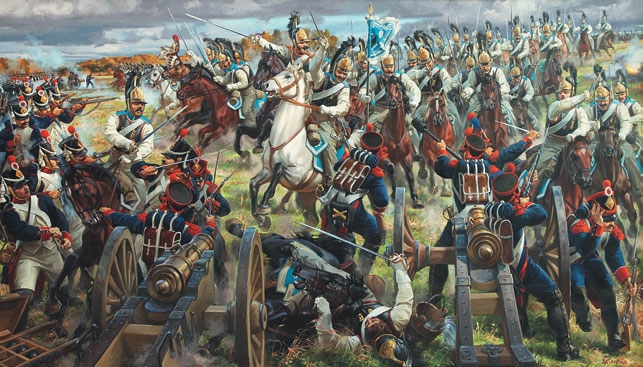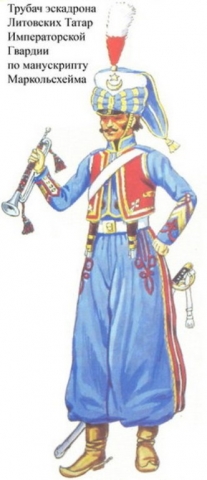In 1812, Napoleon's expansion in Europe led to the next round of Franco-Russian confrontation. On June 12, the Grand Army began crossing of the border river Neman, entered the Russian Empire. It was clear from the very beginning of the war that the French Emperor planned not only to expand his affected zone, but also to get the major concessions from Russia, including territories.
The four cavalry regiments of Crimean Tatars actively fought in the War of 1812 and in the following campaigns in Europe. This regiment was formed by decree of Emperor Alexander I in 1807.The payroll of the officers has been preserved (made in 1808).
Simferopol Regiment:
The commander: Major Kaya bey Balatukov.
Yesauls (Cossack units): Muratsha mirza Shirinskiy, Mustafa mirza, Maksut Bey Biyarslanov, Sefergazy Bey, Abdureim Celebi Ilyasov the 1st.
Sotniks( commander of hundred men ): Murad mirza, Osman Celebi Ilyasov the 2nd, Adilsha mirza, Agi mirza, Permambet Ağa.
Khorunzhyi (Standard-bearers, junior commissioned rank in the Cossack cavalry): Majid ağa, Seit ağa, Ermambet ağa Dzhaminskiy, Osman Ali.
Perekop Regiment:
The commander: Major Ahmed bey Hunkalov the 1st.
Yesauls: Selyamet bey Hunkalov 2nd, Mengli Giray mirza Shirinskiy, Batyr mirza Uzdemnikov 1st, Yahya mirza, Ak Bochala mirza.
Sotniks: Selyamet mirza Hunkalov the 3rd, Batyr Giray Sultan, Hassan mirza Uzdemnikov 2nd, Mustafa mirza Kantakuzen’, Qasim mirza Karashay.
Khorunzhyi: Boisa Ağa, Kaichy ağa, Memedlya mirza Ali, Kendzhamet Ali.
Yevpatoriya Regiment:
The commander: Captain Abdullah ağa Mamayskiy.
Yesauls: Qasim mirza Mansurskyy, Mustafa mirza, Fetlya mirza, Amet mirza Dzhaminskyy, Sadiq ağa Kuntuhanskiy.
Sotniks: Adilsha mirza Karahutskyy, Temirsha mirza Bulgak, Sartlan Karakipchak mirza, Murad mirza, Temir mirza Dzhazherberdynskiy.
Khorunzhyi: Bore-Akay, Ablay Akay Dzhiyenhazy, Omar Beck, Seit Selamet.
Feodosia Regiment:
The commander: Lieutenant Ali mirza Shirinskiy.
Yesauls: Memetsha mirza Shirinskiy the 2nd, Dzhiyenhazy mirza Niyazov, Agi Giray mirza Shirinskiy, Kurt bey Sedzheutskiy, Yah'ya ağa Seydametov.
Sotniks: Abdul Kadyr ağa, Batyrsha mirza Kemelchynskyy, Seid Ali ağa, Kaya mirza Shirinskiy the 4th, Seit Tehmetov.
Khorunzhyi: Seit Omerov, Petlya ağa Omerov, Veli Chaush Aliyev, Jalal Mustafa, Syin Suleiman.
Before the War of 1812, the regiments of Perekopsk and Simferopol were part of Ataman Matvei Platov’s cossack corps. With the beginning of military operations, the Tatar military were assigned to cover the retreat of General Bagration’s army. The first major battle, in which Perekopsk and Simferopol regiments participated, was held at Navahrudak, on June 27-28. In that battle, the Crimean Tatars faced the 5th Polish Corps under the command of General Jozef Poniatowski, which was part of Napoleon's army. As a result of the battle, the enemy’s attack was repulsed, Crimeans celebrated their first success.
During the further retreat to Moscow, the Crimean Tatar regiments repeatedly distinguished themselves in the battles of Grodno, Mogilev and Smolensk. They played an important role in the Battle of Borodino, participating in a swift raid of Platov’s cavalry against the left flank of the French. Subsequently, all four Crimean Tatar regiments took an active part in the European campaign, having finished its battle way in France.
Among Crimean Tatars, officers-participants in the military campaigns of 1812-1814, Knyaz Kaya Balatukov, the commander of the Simferopol regiment, is of particular interest. He was descended from the old Crimean clan. He was well educated, had a good command of French, Greek and Russian as well as his native language. He knew history, geography, algebra and physics also very well. Balatukov enlisted in the military service in 1793. He was the lieutenant colonel when the war began in 1812. He distinguished himself in the several battles, including battles of Borodino and of Tarutino. In December 1812, he was awarded with the Order of St. George of the IV degree. During the war Balatukov was decorated with five orders.
In 1813, the Simferopol regiment reinforced the corps, commanded by General Wittgenstein P.. In the ranks of its sub-unit, Balatukov fought in Poland, Prussia and France. Knyaz Balutukov was promoted to the major general for his displaying of courage in the capture of Danzig. After the Napoleon's armies were defeated in 1814, Crimean Tatar regiments were disbanded. Only one squadron of the Guards was retained for serving in St. Petersburg.
Tartars served not only on the side of the Russian Empire. They also were in the ranks of Napoleon's army. It is about Lithuanian Tatars ( Lipka Tatars), the descendants of the soldiers’ class, which began to settle in Lithuania, Poland and Belarus in the late XIV century. After Napoleon entered the territory of Lithuania in June of 1812, Polish General Sokolnicki M. addressed the letter to the Emperor with the offer to form the regiment of Lithuanian Tatars. In particular he wrote: "Their honesty as well as their courage were tested, and they are eager to serve to the country, which became their homeland for five hundred years ago."
The squadron was formed in October and accepted the first battle in December 1812, which could be the last. At the defense of Wilno, the squadron, which numbered 122 people, lost 98 people with killed and wounded. Among the dead were the commander Mustafa Mirza Akhmatovich. After that fight, the remnants of the formation retreated to the West together with the army of Napoleon.
The new commander of Lithuanian Tatars, Captain Samuel Mirza Ulan made truly heroic efforts to restore the combat capability of his detachment. But in the course of further battles, its number was getting smaller and smaller. By the time of the capitulation of France, only 14 of Lithuanian Tatars left in the rank, led by their commander. After the war they returned to their homeland.
You can find the other materials about "History of Islam in Ukraine" by clicking the following reference.
Olexander Stepanchenko specially for "Islam in Ukraine"




